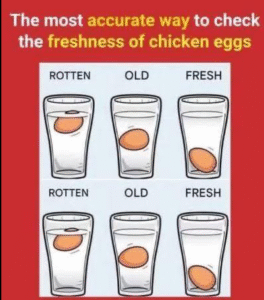The Best Method to Check Egg Freshness (It Actually Works)
When it comes to cooking and baking, fresh eggs are essential—not just for taste, but for safety. While expiration dates printed on cartons are a helpful guideline, they’re not always accurate. Thankfully, there’s a tried-and-true method that really works to check if your eggs are still fresh: the water float test. It’s simple, reliable, and requires nothing more than a bowl of water.
How the Float Test Works
Eggs have a porous shell, which means air can seep in over time. As the egg ages, the contents shrink slightly, and an air pocket begins to form inside. The more air inside the egg, the older it is. The float test takes advantage of this natural process.
To perform the test, fill a bowl or glass with cold water and gently place your egg in. Here’s what the results tell you:
-
Sinks and lays flat on the bottom: The egg is very fresh. You can safely use it for any purpose, including frying or poaching.
-
Sinks but stands upright: The egg is still safe to eat, but it’s older. It’s better used in baking or hard-boiling.
-
Floats to the top: The egg is no longer fresh and should be discarded. The large air pocket indicates it has gone bad.
Why This Method Is So Effective
The float test works because it’s based on the physical changes that occur as eggs age, not on arbitrary dates. Unlike smell tests or cracking the egg open—both of which can be unpleasant or wasteful—the float test keeps everything clean and intact.
Moreover, sometimes eggs are perfectly fine well past their expiration date. Other times, they can spoil earlier than expected due to storage conditions. That’s why relying on the float test gives you a more accurate, real-time assessment of freshness.
Other Signs to Consider
While the float test is the best method, you can combine it with other observations to be extra sure:
-
Shake Test: Hold the egg next to your ear and gently shake it. If you hear sloshing, the egg is likely old.
-
Visual Inspection: If you crack the egg open and notice a strange color (like pink or green), or if it smells bad, toss it out immediately.
-
Yolk and White Consistency: Fresh eggs have firm yolks and thick whites. Older eggs will appear more watery and spread out more in the pan.
Final Tips
Store your eggs in the fridge, preferably in the original carton. Keep them away from the fridge door, where temperature fluctuates the most. And remember: while the float test is highly effective, always trust your senses. If something looks or smells off, it’s better to be safe than sorry.
The Best Method to Check Egg Freshness (It Actually Works)
When it comes to cooking and baking, fresh eggs are essential—not just for taste, but for safety. While expiration dates printed on cartons are a helpful guideline, they’re not always accurate. Thankfully, there’s a tried-and-true method that really works to check if your eggs are still fresh: the water float test. It’s simple, reliable, and requires nothing more than a bowl of water.
How the Float Test Works
Eggs have a porous shell, which means air can seep in over time. As the egg ages, the contents shrink slightly, and an air pocket begins to form inside. The more air inside the egg, the older it is. The float test takes advantage of this natural process.
To perform the test, fill a bowl or glass with cold water and gently place your egg in. Here’s what the results tell you:
-
Sinks and lays flat on the bottom: The egg is very fresh. You can safely use it for any purpose, including frying or poaching.
-
Sinks but stands upright: The egg is still safe to eat, but it’s older. It’s better used in baking or hard-boiling.
-
Floats to the top: The egg is no longer fresh and should be discarded. The large air pocket indicates it has gone bad.
Why This Method Is So Effective
The float test works because it’s based on the physical changes that occur as eggs age, not on arbitrary dates. Unlike smell tests or cracking the egg open—both of which can be unpleasant or wasteful—the float test keeps everything clean and intact.
Moreover, sometimes eggs are perfectly fine well past their expiration date. Other times, they can spoil earlier than expected due to storage conditions. That’s why relying on the float test gives you a more accurate, real-time assessment of freshness.
Other Signs to Consider
While the float test is the best method, you can combine it with other observations to be extra sure:
-
Shake Test: Hold the egg next to your ear and gently shake it. If you hear sloshing, the egg is likely old.
-
Visual Inspection: If you crack the egg open and notice a strange color (like pink or green), or if it smells bad, toss it out immediately.
-
Yolk and White Consistency: Fresh eggs have firm yolks and thick whites. Older eggs will appear more watery and spread out more in the pan.
Final Tips
Store your eggs in the fridge, preferably in the original carton. Keep them away from the fridge door, where temperature fluctuates the most. And remember: while the float test is highly effective, always trust your senses. If something looks or smells off, it’s better to be safe than sorry.
